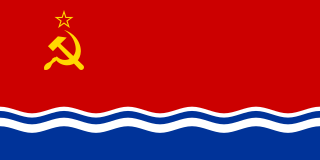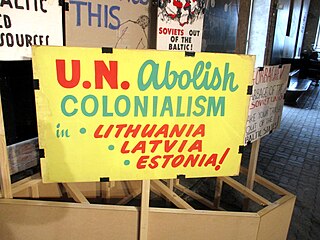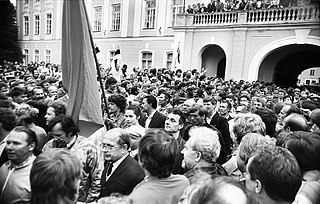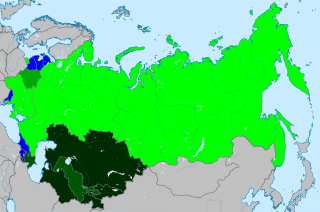| |||||
| Decades: | |||||
|---|---|---|---|---|---|
| See also: | Other events in 1989 Timeline of Estonian history | ||||
This article lists events that occurred during 1989 in Estonia .
| |||||
| Decades: | |||||
|---|---|---|---|---|---|
| See also: | Other events in 1989 Timeline of Estonian history | ||||
This article lists events that occurred during 1989 in Estonia .

The history of Estonia forms a part of the history of Europe. Humans settled in the region of Estonia near the end of the last glacial era, beginning from around 8500 BC.

The flag of Estonia is a tricolour featuring three equal horizontal bands of blue (top), black (middle), and white (bottom). In Estonian it is colloquially called the sinimustvalge.

The Singing Revolution was a series of events in 1987–1990 that led to the restoration of independence of the three then Soviet-occupied Baltic countries of Estonia, Latvia, and Lithuania at the end of the Cold War. The term was coined by an Estonian activist and artist, Heinz Valk, in an article published a week after the 10–11 June 1988 spontaneous mass evening singing demonstrations at the Tallinn Song Festival Grounds.

The Latvian Soviet Socialist Republic, also known as Soviet Latvia or simply Latvia, was a republic in the Soviet Union. The Latvian SSR was in existence for just over 50 years, from August 5, 1940, to September 6, 1991.

The three independent Baltic countries – Estonia, Latvia, and Lithuania – were invaded and occupied in June 1940 by the Soviet Union, under the leadership of Stalin and auspices of the Molotov-Ribbentrop Pact that had been signed between Nazi Germany and the Soviet Union in August 1939, immediately before the outbreak of World War II. The three countries were then annexed into the Soviet Union in August 1940. The United States and most other Western countries never recognised this incorporation, considering it illegal. On 22 June 1941, Nazi Germany attacked the Soviet Union and within weeks occupied the Baltic territories. In July 1941, the Third Reich incorporated the Baltic territory into its Reichskommissariat Ostland. As a result of the Red Army's Baltic Offensive of 1944, the Soviet Union recaptured most of the Baltic states and trapped the remaining German forces in the Courland Pocket until their formal surrender in May 1945.

The Popular Front of Latvia was a political organisation in Latvia in the late 1980s and early 1990s which led Latvia to its independence from the Soviet Union. It was similar to the Popular Front of Estonia and the Sąjūdis movement in Lithuania.

The Baltic Way or Baltic Chain was a peaceful political demonstration that occurred on 23 August 1989. Approximately two million people joined their hands to form a human chain spanning 690 kilometres (430 mi) across the three Baltic states of Estonia, Latvia and Lithuania, which at the time were occupied and annexed by the USSR. The central government in Moscow considered the three Baltic countries constituent republics of the Soviet Union.

The Intermovement(International Movement of Workers in the Estonian Soviet Socialist Republic) was a political movement and organisation in the Estonian SSR. It was founded on 19 July 1988 and claimed by different sources 16,000 - 100,000 members. The original name of the movement was Interfront, which was changed to Intermovement in autumn 1988.
The Congress of Estonia was an innovative grassroots parliament established in Estonia in 1990–1992 as a part of the process of regaining of independence from the Soviet Union. It also challenged the power and authority of the pre-existing quasi-parliament in the country, called the Supreme Soviet of the Estonian SSR, which had been imposed on Estonia after the Soviet invasion, occupation and illegal annexation of Estonia in 1940. The Congress of Estonia declared that it represented the highest authority on questions of Estonian statehood and citizenship, deriving this authority from the consent and initiative of the citizens of Estonia. The aim of the Congress was to restore Estonian independence based on the principle of legal continuity, with the pre-1940 Republic of Estonia, which had been established in 1918, as the foundation.

The three Baltic countries, or the Baltic states – Estonia, Latvia, and Lithuania – are held to have continued as legal entities under international law while under the Soviet occupation from 1940 to 1991, as well as during the German occupation in 1941–1944/1945. The prevailing opinion accepts the Baltic thesis of illegal occupation and the actions of the USSR are regarded as contrary to international law in general and to the bilateral treaties between the USSR and the three Baltic countries in particular.

The Democratic Party of Russia or DPR is a conservative Russian political party that was founded in 1990. Under the leadership of Andrey Bogdanov, the party advocated the entry of Russia into the European Union. In 2008, the party merged with several others to form the Right Cause. It was re-established as a party and officially registered again in 2012.

The Declaration "On the Restoration of Independence of the Republic of Latvia" was adopted on 4 May 1990 by the Supreme Soviet of the Latvian SSR in which Latvia declared independence from the Soviet Union. The Declaration stated that, although Latvia had de facto lost its independence in 1940, when it was annexed by the Soviet Union, the country had de jure remained a sovereign country as the annexation had been unconstitutional and against the will of the Latvian people. It asserted the priority of the basics of the international law over the national laws and therefore it resolved that the Molotov–Ribbentrop Pact and the Soviet occupation of Latvia in 1940 were illegal. It also asserted that the heavily rigged 1940 elections were illegal and unconstitutional, and that all acts of the People's Saeima chosen at that election–including the request to join the Soviet Union on 21 July 1940–were ipso facto void.
Supreme Soviet elections were held in the Lithuanian SSR on 24 February with run-off elections on 4, 7, 8 and 10 March 1990 to elect the 141 members of the Supreme Soviet. In six constituencies, voter turnout was below the required minimum and a third round was held on 17 and 21 April. For the first time since 1940 elections to the People's Seimas, non-communist candidates were allowed to run. The elections were the first free nationwide elections since 1926, and only the fifth free elections in all of Lithuanian history.
Elections to the Supreme Soviet were held in the Estonian SSR on 18 March 1990. Altogether 392 candidates ran for the Soviet-style legislature's 105 seats, of which four were pre-allocated to the military districts of the Soviet Army. The pro-independence Popular Front won the plurality. The coalition of the reformed Estonian communists, who favored independence but close relations with the USSR and were supported by Indrek Toome who was running under the Free Estonia banner, won 27 seats. The anti-independence, pro-Moscow "Joint Soviet of Work Collectives", representing mostly the ethnic Russian immigrant minority in Estonia, won 25 seats. During its first session, the new legislature elected the former Communist Party member Arnold Rüütel as its chairman, allowing him to stay as the nominal leader of Estonia.

A referendum on the future of the Soviet Union was held on 17 March 1991 across the Soviet Union. It was the only national referendum in the history of the Soviet Union, although it was boycotted by authorities in six of the fifteen Soviet republics.

The Estonian Soviet Socialist Republic, also known as the Estonian SSR, Soviet Estonia, or simply Estonia, was a union republic and an ethnically based administrative subdivision of the former Soviet Union (USSR) covering the occupied and annexed territory of Estonia in 1940–1941 and 1944–1991. The Estonian SSR was nominally established to replace the until then independent Republic of Estonia on 21 July 1940, a month after the 16–17 June 1940 Soviet military invasion and occupation of the country during World War II. After the installation of a Stalinist government which, backed by the occupying Soviet Red Army, declared Estonia a Soviet constituency, the Estonian SSR was subsequently incorporated into the Soviet Union as a "union republic" on 6 August 1940. Estonia was occupied by Nazi Germany in 1941, and administered as a part of Reichskommissariat Ostland until it was reconquered by the USSR in 1944.

The three Baltic states – Estonia, Latvia and Lithuania – were re-occupied in 1944–1945 by the Soviet Union (USSR) following the German occupation. The Baltic states regained independence in 1990–1991.

The dissolution of the Soviet Union was the process of internal disintegration within the Soviet Union (USSR) which resulted in the end of the country's and its federal government's existence as a sovereign state, thereby resulting in its constituent republics gaining full independence on 26 December 1991. It brought an end to General Secretary Mikhail Gorbachev's effort to reform the Soviet political and economic system in an attempt to stop a period of political stalemate and economic backslide. The Soviet Union had experienced internal stagnation and ethnic separatism. Although highly centralized until its final years, the country was made up of 15 top-level republics that served as homelands for different ethnicities. By late 1991, amid a catastrophic political crisis, with several republics already departing the Union and the waning of centralized power, the leaders of three of its founding members declared that the Soviet Union no longer existed. Eight more republics joined their declaration shortly thereafter. Gorbachev resigned in December 1991 and what was left of the Soviet parliament voted to end itself.
This article lists events that occurred during 1990 in Estonia.
The political history of Estonia covers the political events and trends in the country throughout its historical period.